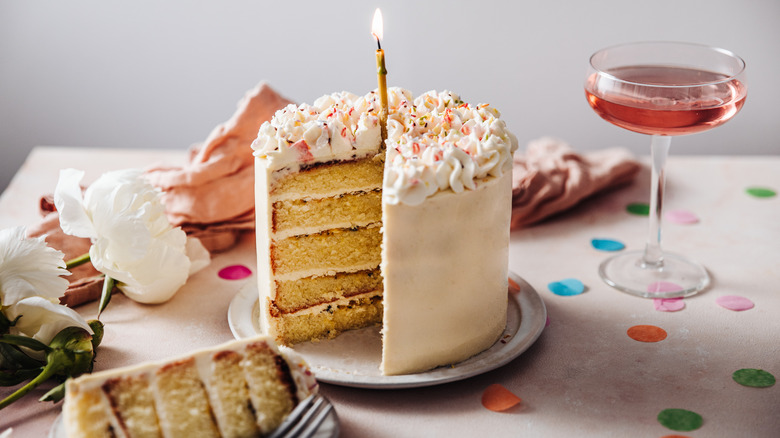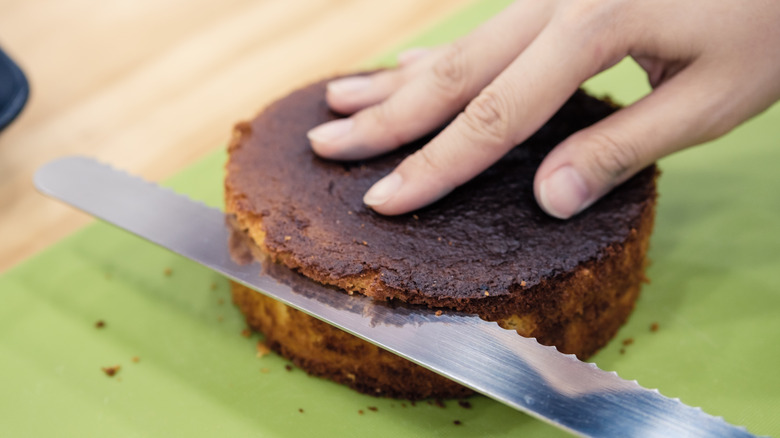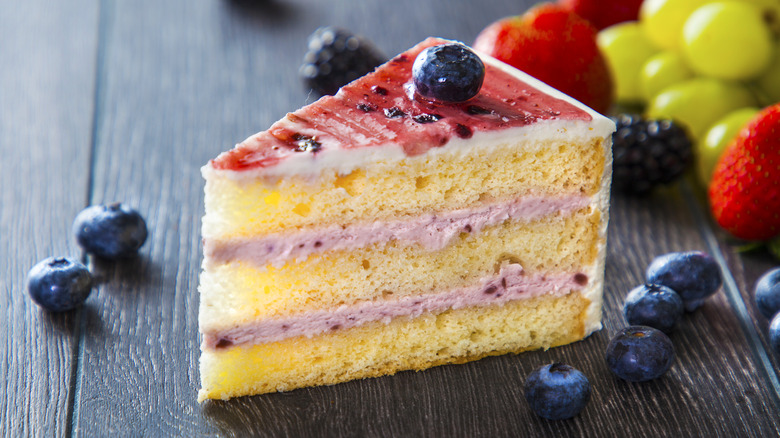The Best Kind Of Knife To Use For Cutting Cake Layers
Layer cake is one of life's simple pleasures, best enjoyed with friends and loved ones as an undeniable symbol of celebration (hello, five-layer wine and berry chocolate anniversary cake). And it's relatively simple to make, too. If you have the right baking knowledge and kitchen tools, you can achieve the infamous clean, defined layers that look stunning when you go to remove the first slice. There is, in particular, one must-have tool for cutting cake into even layers without compromising their texture: a serrated knife.
Compared to a chef's knife (which has a smooth, shape blade and relies on downward force and pressure to chop food), a serrated knife, with its jagged or scalloped edges, employs a gentle sawing motion to cut cake into layers ready to be filled and frosted, all without compacting the soft, fluffy cake.
Any bread knife with sharp, ridged edges will do the cake-cutting job well. Just like using a serrated bread knife to slice a hearty fresh-baked ciabatta loaf, you can use a serrated knife to cut even cake layers without smashing their delicate, airy crumb structure. And you likely already have one on hand. If you don't, while there are expensive serrated knife options out there, you can buy a good serrated bread knife for $25 or less.
How to use a serrated knife to cut delicate layers
To use a serrated knife to cut seamless layers for a homemade chocolate chip layer cake, first remove your baked and cooled cake from its pan, inserting a knife along the edges between the cake and the pan to help it release. Invert your cake onto a stable cutting board or work surface, place it on a flat base, then locate your serrated knife.
To cut the cake into two even layers, use one hand to hold your knife perpendicularly to yourself, while you stabilize the base of the cake with your other hand. Next, draw an outline around the cutting-area with the edge of the knife to give yourself a framework for a smooth, even cut (use a cake decorating turntable to easily trace a circle around the outer edge). Then, use the serrated knife to gently saw the cake down the middle horizontally, until you've cut your way through the cake and have two layers.
Note: if your cake top is especially rounded, first remove the top with your serrated knife to create a flat top surface. Follow as similar process — to remove the rounded top, gently saw the rounded portion of the cake off in an even line, then slice your cake into layers.
Troubleshooting tips for cutting and assembling cakes
Once you know how to cut cake into clean layers with a serrated knife, you'll be well on your way to making delicious and artfully beautiful cakes for any ritual or celebration. And don't stop at a simple down-the-middle cut. Slice your cake round into a few thin layers for a sophisticated look and a cake that emphasizes a generous frosting-to-cake ratio.
When embarking on your first few layer cakes, do know that all great bakers go through a learning phase, where baking mishaps are sure to happen. Even with the best intentions (and quality serrated knives), sometimes cake layers don't come out exactly as you'd like. If you're new to the trade, you could end up with a lopsided layer. Or if there is still an excess of crumbs and breakage when you slice your layers with a serrated knife, you could be cutting your cake when it's too hot. Instead, allow it to cool completely, so it's easier to work with.
If any of these cake layer mistakes do happen, it's okay — icing is your best friend. Use silky Swiss meringue frosting or classic American buttercream to mold and fill in any rough spots or uneven cuts of your cake. When you are dishing out slices to your friends, chances are they'll hardly notice (and will probably be grateful for the extra sweetness between delicate layers).


